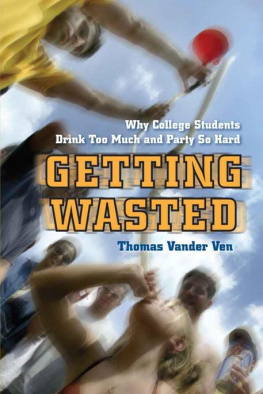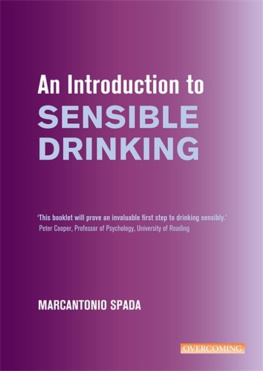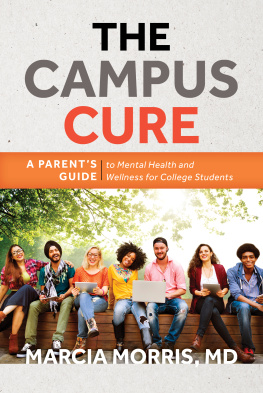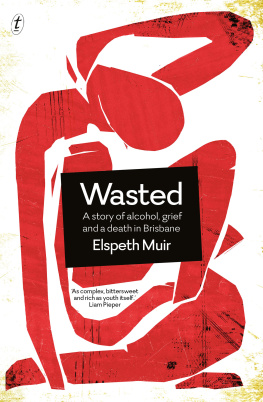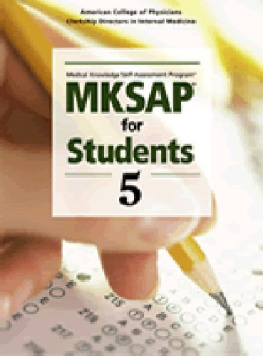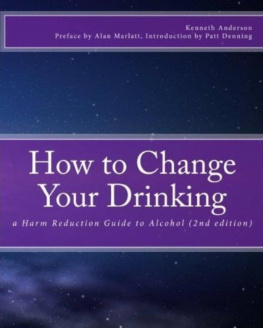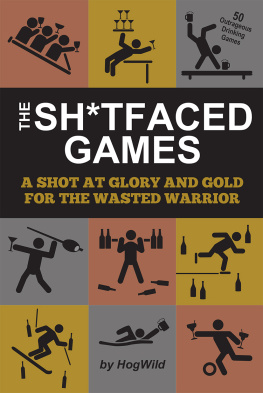GETTING WASTED
Getting Wasted
Why College Students Drink Too Much and Party So Hard
Thomas Vander Ven

NEW YORK UNIVERSITY PRESS
New York and London
www.nyupress.org
2011 by New York University
All rights reserved
References to Internet websites (URLs) were accurate at the time of writing.
Neither the author nor New York University Press is responsible for URLs
that may have expired or changed since the manuscript was prepared.
Library of Congress Cataloging-in-Publication Data
Vander Ven, Thomas, 1966
Getting wasted : why college students drink too much and party so hard/
Thomas Vander Ven.
p. cm.
Includes bibliographical references and index.
ISBN 9780814788318 (cl : alk. paper) ISBN 9780814788325
(pb : alk. paper) ISBN 9780814788400 (e-book)
1. College studentsAlcohol useUnited States. I. Title.
HV5135.V36 2011
362.292208420973dc22 2011005585
New York University Press books are printed on acid-free paper,
and their binding materials are chosen for strength and durability.
We strive to use environmentally responsible suppliers and materials
to the greatest extent possible in publishing our books.
Manufactured in the United States of America
c 10 9 8 7 6 5 4 3 2 1
p 10 9 8 7 6 5 4 3 2 1
For Tory and Sam
CONTENTS
PREFACE
Getting Wasted is the product of over seven years of research and writing. Before I started this project in 2003, it never occurred to me to study university drinking cultures. Like so many people who live and work in college towns, I was well aware of alcohols mammoth presence on campus but I regarded heavy drinking among college students as obvious, self-explanatory, and inevitable. I think most people see college drinking in this way: Of course they are getting wasted; theyre in college! How has our society come to see college and drinking as synonymous? Maybe this is the case because our popular culture often depicts university life in this way. Animal House , a seminal film about a group of drunken, out-of-control, anti-intellectual fraternity guys, was a must-see movie for those of us who grew up in the 1970s. And most of the feature films about college life released since Animal House have reproduced similar themes. That is, most Hollywood depictions of college life suggest that it is all about drinking, sex, and finding ways to succeed without actually doing any real studying.
And maybe many people blindly accept the college is drinking theme because that is how university culture was originally presented to them by parents and older siblings. When I was a high school student in the early 1980s, my friend and I visited my older sister at Gettysburg College, a well-respected liberal arts school in Pennsylvania. Lets just say that we didnt tour the library, perform scientific experiments, or explore the mysteries of mathematics while we were there. As far as I could tell from my brief weekend visit, many Gettysburg students were getting hammered as if their lives depended on it. A couple of years later, in 1984, I enrolled as a freshman at Indiana University. I am a proud Indiana alumnus. There are many outstanding academic programs, faculty, and students there. But, make no mistake about it, there was (and still is) some serious partying going on there. And I never questioned it. Alcohol just appeared to be a necessary part of the social and cultural landscape. Furthermore, I dont remember university administrators, parents, or social critics fretting much about alcohol abuse on campus in those days. It was a given.
In 2001, I accepted a job as an assistant professor of sociology and criminology at Ohio University. My wife and I were thrilled. We had always wanted to live in a college town and, as college towns go, few are more beautiful or more idyllic than Athens, Ohio. Ohio University is a fine institution with many highly regarded programs throughout the school. And, according to the Princeton Review, it is also currently ranked as the number two party school in the nation. There are good reasons to be critical of the Princeton Reviews party school list. Critics of the list have called the Princeton study unscientific, pointing out that sometimes as few as 1 percent of the students at a given institution are surveyed in order for a school to achieve the party school distinction. But just as it is for university students across the nation, drinking is an important part of the college experience for some Ohio University students. I became aware of this fact soon after I arrived in Athens but, again, I regarded the party scene with an uncritical eye.
And then, in 2003, I had sort of a revelation. By this time, a large body of scholarly literature had emerged about alcohol use and abuse among college students. Most researchers agreed that heavy drinking on American campuses was a problem. On the basis of survey results, scholars argued that binge drinking was a common activity and that alcohol abuse on campus was associated with a variety of negative outcomes, including school failure, vandalism, violent assaults, and sexual victimization. These findings were not particularly controversial. Most people would agree that drunk people have a tendency to get into trouble. For me, however, the growing body of college alcohol research studies told only part of the story. I was already convinced that many college students drank and that heavy alcohol consumption had some deleterious effects, but I was concerned that scholars had focused almost exclusively on surveying individuals and had not attempted to understand the social processes of alcohol use on campus. That is, researchers would generally ask individual college students about their drinking habits and about the consequences of their consumption, but paid scant attention to the ways in which students drank together. This seemed like a glaring omission to me. I suspected that these young men and women worked together to decide when to drink, what to drink, and how much to consume, and collaborated together to manage the variety of consequences that they were likely to face in the drinking scene. I began to see college drinking in a brand new way, and since I worked and lived in a college town, I saw an opportunity to study this topic up close and in depth. I began to see the college campus and the drinking culture within it as a social laboratory. Through my professional contacts, I was able to investigate the university drinking scene at three different campuses. The majority of my data were collected at a large state university in the American Midwest (hereafter referred to by the pseudonym Midwestern State University).
What I found out during my research was fascinating to me and, by turns, both entertaining and troubling. For one thing, there is a powerful duality present in the college party culture. Sometimes it appears that college drinkers are having the time of their lives. A few years ago, my son Sam (who was about seven years old at the time) looked out the window of our car at a group of college students drinking beer and playing a game of cornhole (a simple competition that involves throwing beanbags into a hole) at a house party. Admiring their gathering, which was a familiar sight to him by now, Sam announced excitedly, Look at them; thats just classic! I knew exactly what he meant. There is a vibrancy and camaraderie emanating from student parties that is simply undeniable. On the other hand, darkness, destruction, and violence are also always lurking in the college drinking scene. Just today, I read an internet report about a University of Idaho senior who recently died of respiratory failure after reportedly drinking over fifteen shots in two and half hours to celebrate his twenty-first birthday. So, while it was apparent to me that college students were having fun when they drank together, I also knew that sometimes things got ugly; sometimes the vibrancy and camaraderie ends in tragedy. This idea led me to a basic research question: Why do university students continue to consume large amounts of alcohol when so many bad things can and do emerge as a result? This book is, in part, an attempt to answer that question.
Next page
